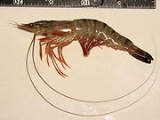
Penaeus monodon
Encyclopedia
Penaeus monodon, the giant tiger prawn (and also known by other common name
s), is a marine crustacean
that is widely reared for food.
, ranging from the eastern coast of Africa
, the Arabian Peninsula
, as far as South-east Asia, the Sea of Japan
and northern Australia
.
, Litopenaeus vannamei. In 2009, 770,000 tonne
s was produced, with a total value of US$
3,650,000,000.
added Penaeus monodon to its seafood red list – "a list of fish that are commonly sold in supermarkets around the world, and which have a very high risk of being sourced from unsustainable fisheries". The reasons given by Greenpeace were "destruction of vast areas of mangroves in several countries, over-fishing of juvenile shrimp from the wild to supply farms, and significant human rights abuses".
Common name
A common name of a taxon or organism is a name in general use within a community; it is often contrasted with the scientific name for the same organism...
s), is a marine crustacean
Crustacean
Crustaceans form a very large group of arthropods, usually treated as a subphylum, which includes such familiar animals as crabs, lobsters, crayfish, shrimp, krill and barnacles. The 50,000 described species range in size from Stygotantulus stocki at , to the Japanese spider crab with a leg span...
that is widely reared for food.
Distribution
The natural distribution is Indo-West-PacificIndo-Pacific
The Indo-Pacific is a biogeographic region of the Earth's seas, comprising the tropical waters of the Indian Ocean, the western and central Pacific Ocean, and the seas connecting the two in the general area of Indonesia...
, ranging from the eastern coast of Africa
Africa
Africa is the world's second largest and second most populous continent, after Asia. At about 30.2 million km² including adjacent islands, it covers 6% of the Earth's total surface area and 20.4% of the total land area...
, the Arabian Peninsula
Arabian Peninsula
The Arabian Peninsula is a land mass situated north-east of Africa. Also known as Arabia or the Arabian subcontinent, it is the world's largest peninsula and covers 3,237,500 km2...
, as far as South-east Asia, the Sea of Japan
Sea of Japan
The Sea of Japan is a marginal sea of the western Pacific Ocean, between the Asian mainland, the Japanese archipelago and Sakhalin. It is bordered by Japan, North Korea, Russia and South Korea. Like the Mediterranean Sea, it has almost no tides due to its nearly complete enclosure from the Pacific...
and northern Australia
Australia
Australia , officially the Commonwealth of Australia, is a country in the Southern Hemisphere comprising the mainland of the Australian continent, the island of Tasmania, and numerous smaller islands in the Indian and Pacific Oceans. It is the world's sixth-largest country by total area...
.
Description
Females can reach approximately 33 centimetres (13 in) long, but are typically 25–30 cm (9.8–11.8 ) long and weight 200–320 g (7.1–11.3 ); males are slightly smaller at 20–25 cm (7.9–9.8 ) long and weighing 100 gram.Aquaculture
Penaeus monodon is the most widely cultured prawn species in the world, although it is gradually losing ground to the whiteleg shrimpWhiteleg shrimp
Whiteleg shrimp , also known as Pacific white shrimp, is a variety of prawn of the eastern Pacific Ocean commonly caught or farmed for food.-Description:...
, Litopenaeus vannamei. In 2009, 770,000 tonne
Tonne
The tonne, known as the metric ton in the US , often put pleonastically as "metric tonne" to avoid confusion with ton, is a metric system unit of mass equal to 1000 kilograms. The tonne is not an International System of Units unit, but is accepted for use with the SI...
s was produced, with a total value of US$
United States dollar
The United States dollar , also referred to as the American dollar, is the official currency of the United States of America. It is divided into 100 smaller units called cents or pennies....
3,650,000,000.
Sustainable consumption
In 2010, GreenpeaceGreenpeace
Greenpeace is a non-governmental environmental organization with offices in over forty countries and with an international coordinating body in Amsterdam, The Netherlands...
added Penaeus monodon to its seafood red list – "a list of fish that are commonly sold in supermarkets around the world, and which have a very high risk of being sourced from unsustainable fisheries". The reasons given by Greenpeace were "destruction of vast areas of mangroves in several countries, over-fishing of juvenile shrimp from the wild to supply farms, and significant human rights abuses".

